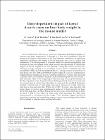| dc.contributor.author | HOLLAND, CELIA | en |
| dc.contributor.author | STAFFORD, PETER | en |
| dc.date.accessioned | 2010-06-17T10:53:36Z | |
| dc.date.available | 2010-06-17T10:53:36Z | |
| dc.date.issued | 2009 | en |
| dc.date.submitted | 2009 | en |
| dc.identifier.citation | Lewis, R., Behnke, J., Stafford, P. & Holland, C., Dose-dependent impact of larval Ascaris suum on host body weight in the mouse model, Journal of Helminthology, 83, 2009, 1 - 5 | en |
| dc.identifier.other | Y | en |
| dc.identifier.uri | http://hdl.handle.net/2262/40170 | |
| dc.description | PUBLISHED | en |
| dc.description.abstract | Ascaris lumbricoides and Ascaris suum are important helminth parasites of humans and pigs, respectively. Although it is now well established that the presence of mature adult worms in the host intestine contributes to significant nutritional morbidity, the impact of larval migratory ascariasis is far less well understood. The development of a mouse model to explore susceptibility and resistance to larval ascariasis in the lungs provided an opportunity to observe the impact of larval migration on host growth during the course of infection. Changes in body weight were monitored in two strains of inbred mice, the susceptible C57BL/6j and the resistant CBA/Ca. Groups of mice received one of four doses: 100, 500, 1000 and 3000 fully embryonated A. suum ova. Infected mice underwent post-mortem on days 6, 7 and 8 post-infection. Control mice received a placebo dose of intubation medium and underwent post-mortem on day 7 post-infection. Mice were weighed pre-infection (day 0) and post-infection on the day of post-mortem. At post-mortem, the lungs of each mouse were removed for enumeration of Ascaris larval burdens by means of the modified Baermann method. Control mice of each strain showed an increase in weight from pre-infection to post-infection day. Within the C57BL/6j strain, mice infected with higher doses of Ascaris eggs experienced a reduction in body weight; for those given 3000 eggs this was on all three post-mortem days, and for those given 1000, on days 7 and 8. For CBA/Ca mice, only mice receiving the 3000 dose demonstrated a reduction in body weight. These findings suggest that larval migratory ascariasis has a significant negative impact upon host growth and that this is related to infective dose and larval burden. | en |
| dc.format.extent | 1 | en |
| dc.format.extent | 5 | en |
| dc.language.iso | en | en |
| dc.relation.ispartofseries | Journal of Helminthology | en |
| dc.relation.ispartofseries | 83 | en |
| dc.rights | Y | en |
| dc.subject | Zoology | en |
| dc.subject | helminths | en |
| dc.subject | Ascaris lumbricoides | en |
| dc.subject | Ascaris suum | en |
| dc.title | Dose-dependent impact of larval Ascaris suum on host body weight in the mouse model | en |
| dc.type | Journal Article | en |
| dc.type.supercollection | scholarly_publications | en |
| dc.type.supercollection | refereed_publications | en |
| dc.identifier.peoplefinderurl | http://people.tcd.ie/cholland | en |
| dc.identifier.rssinternalid | 48035 | en |
| dc.subject.TCDTheme | Immunology, Inflammation & Infection | en |
| dc.identifier.rssuri | http://dx.doi.org/10.1017/S0022149X08912402 | en |
| dc.contributor.sponsor | Irish Research Council for Science and Engineering Technology (IRCSET) | en |




